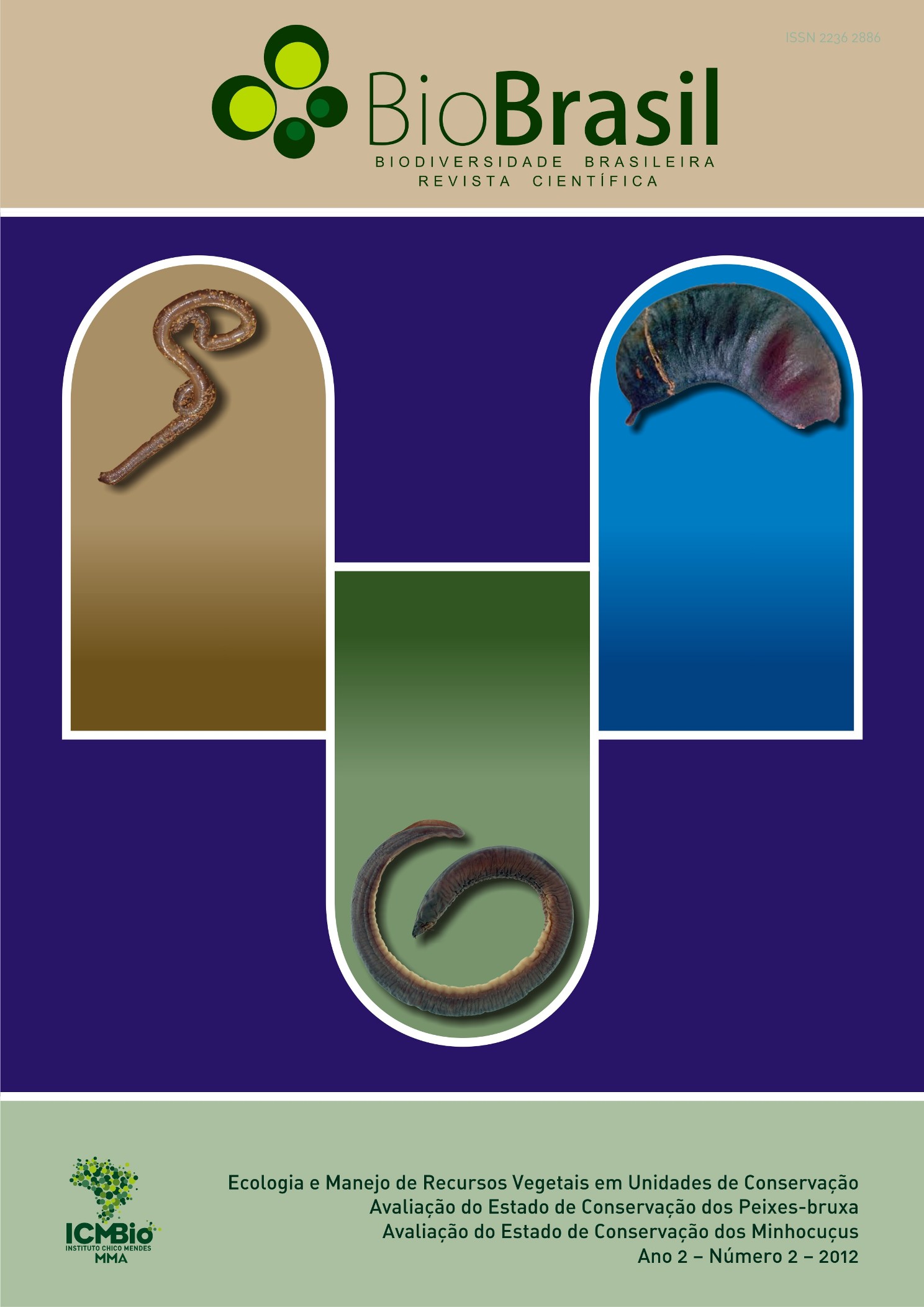A importância das unidades de conservação na manutenção da diversidade genética de xaxim Dicksonia sellowiana no Estado de Santa Catarina
DOI:
https://doi.org/10.37002/biodiversidadebrasileira.v2i2.271Keywords:
in situ conservation, isozymes, plant genetic resources, protected areas, tree fernAbstract
Dicksonia sellowiana Presl. (Hooker) (Dicksoniaceae), known as xaxim, is a tree fern species
from Atlantic Rainforest, characteristic of Mixed Ombrophilous Forest typology. Dicksonia sellowiana is an
endangered species with economic potential and ecologic importance. The aim of this study was to compare
the species genetic diversity, evaluated within and outside protected areas (PA), in order to verify the PA
effectiveness on xaxim genetic conservation. It was sampled 30 populations of xaxim throughout its area
of natural occurrence in Santa Catarina State, seven of them are in PA and 23 in private areas. Compared
with the 23 private areas, the seven within PA retain about 90% of sampled alleles (24 of 26) and the same
genetic diversity magnitude (Ĥe
= 0.147). The Fˆ
st values show that half of xaxim genetic variability is among
the populations, suggesting that a good conservation strategy must include a great number of populations.
It becomes evident PA's importance on the genetic diversity conservation of D. sellowiana, but also for
researches about plant genetic resources conservation and use
Downloads
References
Alfenas, A.C. 1998. Eletroforese de isoenzimas e proteínas afins: fundamentos e aplicações em plantas e microorganismos. Viçosa: Editora Universidade Federal de Viçosa.
Auler, N.M.F.; Reis, M.S.; Guerra, M.P. & Nodari, R.O. 2002. The genetics and conservation of Araucaria angustifolia: genetic structure and diversity of natural populations by of means of non-adaptive variation in the state of Santa Catarina. Genet. Mol. Biol., 25: 329-338.
Berg, E.E. & Hamrick, J.L. 1997. Quantification of genetic diversity at allozyme loci. Canadian Journal Forest Research, 27: 415-424.
Brasil, 2008. Ministério do Meio Ambiente. Secretaria de Biodiversidade e Florestas. Cadastro nacional de unidades de conservação. Disponível em (Acesso em 21/02/2012).
Brasil. Ministério do Meio Ambiente. Instrução Normativa n° 6, de 23 de setembro de 2008. Lista oficial das espécies da flora brasileira ameaçadas de extinção. Diário Oficial da República Federativa do Brasil, Brasília, DF, 24 set. 2008. Seção 1, p. 75-83.
Carvalho, P.E.R. 1994. Espécies florestais brasileiras: recomendações silviculturais, potencialidades e uso da madeira. Colombo: EMBRAPA-CNPF.
Duarte, A.S.; Vieira da Silva C.; Puchalski, A.; Mantovani, M.; Silva, J.Z. & Reis. M.S. 2007. Estrutura demográfica e produção de frutos de Bromelia antiacantha Bertol. Revista Brasileira de Plantas Medicinais, 9: 106-112.
Ferreira, D.K.; Nazareno, A.G.; Mantovani, A.; Bittencourt, R.; Sebbenn, A.M.; Reis, M.S. 2012. Genetic analysis of 50-year old Brazilian pine (Araucaria angustifolia) plantations: implications for conservation planning. Conservation Genetics, 13: 435-442. Goudet, J. 2002. FSTAT, a program to estimate and test gene diversities and fixation indices (version 2.9.3).
Guerra, M.P.; Silveira, V.; Reis, M.S. & Schneider, L. 2002. Exploração, manejo e conservação da araucária (Araucaria angustifolia). In: Simões, L.L. & Lino, C.F. (Org.). Sustentável Mata Atlântica: a exploração de seus recursos florestais. São Paulo: Ed. SENAC, 215p.
IBAMA (Instituto Brasileiro do Meio Ambiente e dos Recursos Naturais Renováveis). Lista Oficial das Espécies da Flora Brasileira Ameaçadas de Extinção. Portaria 006/92-N de 15 de janeiro de 1992. Diário Oficial.
Iob, G. & Vieira, E.M. 2008. Seed predation of Araucaria angustifolia (Araucariaceae) in the Brazilian Araucaria Forest: influence of deposition site and comparative role of small and ‘large' mammals. Plant Ecology, 198: 185-196.
Klein, R.M. 1978. Mapa fitogeográfico do Estado de Santa Catarina. Flora Ilustrada Catarinense, 24p. Lewis, P.O. & Zaykin, D. 2001. Genetic Data Analysis (GDA): Computer program for the analysis of allelic data. Versão 1.0.
Mantovani, A.; Morellato, L.P.C. & Reis, M.S. 2006. Internal genetic structure and outcrossing rate in a natural population of Araucaria angustifolia (Bert.) O. Kuntze. J. Hered., 97:466-472.
Mariot, A.; Mantovani, A.; Bittencourt, R.; Ferreira, D.K. & Reis, M.S. 2010. Estrutura populacional e incremento corrente anual de casca-de-anta (Drimys brasiliensis Miers - Winteraceae) em Caçador, Santa Catarina, Brasil. Revista Brasileira de Plantas Medicinais, 12: 168-178.
Marques A.C. & Nucci J.C. 2007. Planejamento, gestão e manejo em unidades de conservação. Revista Ensino e Pesquisa, 4: 33-39.
Paise, G. & Vieira, E.M. 2005. Produção de frutos e distribuição espacial de angiospermas com frutos zoocóricos em uma Floresta Ombrófila Mista no Rio Grande do Sul, Brasil. Revista Brasileira de Botânica, 28: 615 - 625.
Reitz, R. & Klein, R. 1966. Araucariáceas. Flora Ilustrada Catarinense. 65 p.
Seitz, R. 1986. Crow development of Araucaria angustifolia in its natural-environment during sixty years. In: Fujimori, T. & Whitehead, D. (eds). Crow and canopy structure in relation to productivity. Forestry and Forest Products Research Institute. Ed. Ibaraki, Japan, p.129-145.
Shimizu, J.Y.; Jaeger, P. & Sopchaki, S.A. 2000. Variabilidade Genética em uma População Remanescente de Araucária no Parque Nacional do Iguaçu, Brasil. Boletim de Pesquisa Florestal 41: 18-36.
Shimizu, J.Y. & Oliveira, Y.M.M. 1981. Distribuição, variação e usos dos recursos genéticos da araucária no sul do Brasil. Curitiba: EMBRAPA-URPFCS, 9 p.
Silva, J.Z. & Reis, M.S. 2010. Effects of different simulated management intensities on the genetic diversity of a heart-of-palm tree natural population (Euterpe edulis Martius). Silvae Genetica, 59: 201-210.
Stefenon, V.M.; Gailing, O. & Finkeldey, R. 2007. Genetic structure of Araucaria angustifolia (Araucariaceae) populations in Brazil: implications for the in situ conservation of genetic resources. Plant Biol., 9: 516-525.
Vibrans, A.C.; Sevegnani, L.; Gasper, A.L. & Lingner, D.V. 2012. Inventário Florístico Florestal de Santa Catarina - Diversidade e Conservação dos Remanescentes Florestais. Blumenau: Editora da FURB. (no prelo)
Downloads
Published
Issue
Section
License
Copyright (c) 2012 Os autores mantêm os direitos autorais de seus artigos sem restrições, concedendo ao editor direitos de ção não exclusivos.

This work is licensed under a Creative Commons Attribution-NonCommercial-NoDerivatives 4.0 International License.
Os artigos estão licenciados sob uma licença Creative Commons Atribuição-NãoComercial-SemDerivações 4.0 Internacional (CC BY-NC-ND 4.0). O acesso é livre e gratuito para download e leitura, ou seja, é permitido copiar e redistribuir o material em qualquer mídia ou formato.












